|
Gliders (aka
sailplanes) have always attracted me because of their sleek lines and graceful,
silent flight. As a sailboat requires its pilot to possess a knowledge of how to
exploit properties of air currents to propel his water craft, so, too, must a
glider pilot know how to interpret and predict air currents to enable long
flights of his aircraft. As an enthusiast and practitioner of both model and
full-size boats and airplanes (many moons ago), I have great appreciation for
both motor-powered and nature-powered versions, but given a choice between the
two, I'll take the sailplane and the sailboat most of the time. It was not until
materials science was able to produce spars and skins strong and light enough
for enabling high aspect ratio wings that glider transformed from pudgy and boxy
to lean and highly aerodynamic. High performance sailplanes can achieve greater
than 40:1 glide ratios, meaning 40,000 feet (7½ miles) horizontally for every
1,000 feet of altitude lost (in neutral air). In 1945 when this "Glight!"
article appeared in Flying Age magazine, the aforementioned materials
discoveries had either not yet been made or not yet applied to glider airframes,
as can be seen in these photos. The most graceful is probably the gull-winged Minimoa,
but it is still a long way from modern carbon fiber models.
Glight! (Glider Flight)
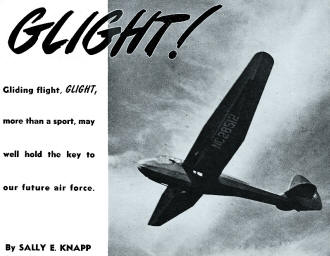
Flight is ,never so free, so graceful as in a glider. The Schweizer
TG-2 aloft. Hans Groenhoff photo.
Gliding flight, Glight, more than a sport, may well hold the key to our future
air force.
By Sally E. Knapp
The step-child of aviation is finally coming into her own.
So definitely did the war establish the utility of the glider, that no one will
ever again question its value, not only as the instrument of a fascinating sport,
but as a military weapon, a potential commercial carrier, and a laboratory for scientific
research as well.
Flight without power was given its first real boost in this country when Congress
recently passed a bill which recognizes the value of gliding as preliminary training
for all pilots. This measure, allowing pilots to glide as much as fifty percent
of the hours required for a private license, and up to twenty-five percent of the
flight time required for a commercial license, is strong evidence that our government
has learned a valuable lesson from the bitter experience of pilot shortages in the
early days of the war.
There is no way of truly estimating how much American air power suffered because
we were so much slower than the enemy to learn the value of motorless flight as
precombat training. We do know that in one respect, at least, we missed the boat.
We know now that Germany's vast reservoir of glider pilots was a strong factor
in making the Luftwaffe the powerful menace in European skies that it was during
the first years of the war. Wiser in the ways of military preparedness than peace-loving
nations, she had begun years before to subsidize a glider training program for all
high-school boys. Every physically-fit, teen-aged German male was in this way exposed
to an ideal screening process which eliminated those unfit to fly before they ever
got into the more expensive power plane training. Out of this process emerged a
strong nucleus of young men for future combat instruction.
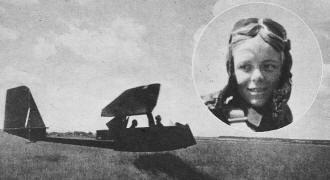
Of all the United Nations, only the Soviet Union made proficient
use of gliders to train its fliers. Women, too, were encouraged to glide first,
then fly. And from the ranks of the gliders came many of Russia's aces. Sovfoto
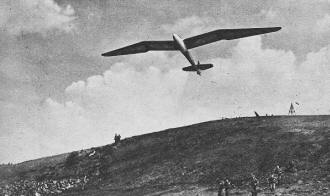
Out of the glider clubs that grew up in defeated, disarmed Germany,
the Nazis built a mighty Luftwaffe. Gliders taught that nation to fly. Shown here
is the graceful, gull-winged Minimoa.
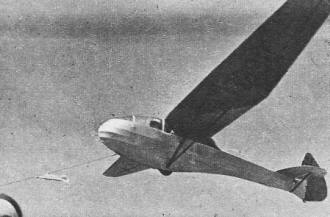
A Schweizer sailplane takes off in tow swiftly, easily.
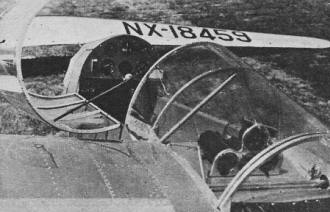
Simpler and neater is the instrument panel of a glider. Three
Lions photo
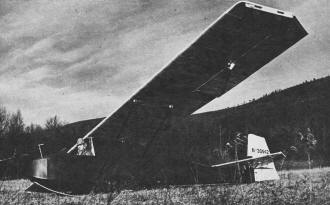
Alexis Dawydoff in the sailplane he adapted from the British
Kirby Kadet for classroom construction from a packaged kit. Hans Groenhoff photo
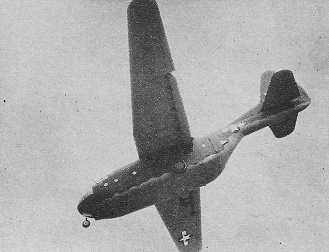
Out of the wartime invasion uses of such gliders as this CG-10
came the plans for commercial cargo glider trains. Acme photo.
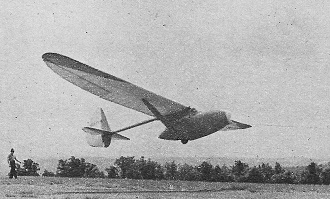
Trim lines and high-lift wings in sailplanes like this Balsy
Bowlus often set the key for aircraft experimentation.
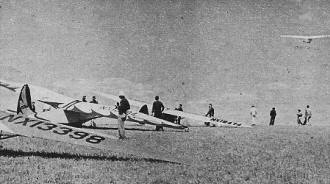
Gliding has a growing following. Here members of a gliding
club line up to be towed aloft by a hired power plane.
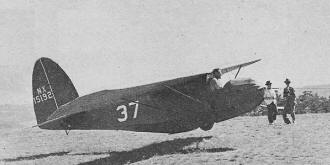
Beginners learn in primary gliders which, unlike the more graceful
sailplanes, cannot soar above the release point.
Only Russia, of all the major allied nations was equally astute in understanding
the value of glider training. As a country, perhaps more air-minded than any other
in the world, she organized a national program of flight indoctrination in the years
before the war, with glider training for both men and women. Consequently at the
outbreak of the war, Russia had a valuable military reserve of 1,000,000 certified
pilots.
Out of the war came many non-military uses of the glider. One of -these, the
commercial use of glider fleets for carrying cargo by air, stems directly from our
experience with the CG4A glider used so successfully for invasion. Its successor,
designated as CG13A, now in production, has a wing span not much less than the DC-3,
can carry 4,000 pounds along with thirty passengers and crew members, and is equipped
with all flight instruments, radio, tricycle landing gear, brakes, and could even
be equipped with an automatic pilot. This, says one airline official, is what mail
houses will use extensively in the future to distribute goods from main warehouses
to branch stores. Such glider fleets, he maintains, will also be invaluable to the
airlines in transportation of perishable goods.
It is hard to say where the sport ends and where the scientific study begins
in soaring, for every flight, is a study in air currents, and every experimental
jaunt made by an amateur enthusiast with it new gadget on his sailplane, adds to
our knowledge of the structure of aircraft.
This is more true of soaring than gliding. The distinction is this: Gliding,
being a more elementary training technique, consists of dropping from the release
point to the ground. Soaring is an advanced form in which altitudes above that of
the launching point are attained by using upward air currents.
Motorless flight provides more of a challenge to the pilot, a more satisfying
proving ground for the engineer and scientist, than any other branch of aviation.
Perhaps this, more than any other reason, promises gliding and soaring a brilliant
future with Americans, who love a challenge.
The Soaring Society of America, a national organization of glider enthusiasts,
has been working against tremendous odds to promote interest in motorless flight
in this country. Without government subsidies such as many European countries grant,
its work has necessarily been limited. The British government, for instance, has
been giving direct subsidies of up to seventy percent of equipment and operating
costs to private glider clubs for some time. As a result England has today an outstanding
national glider program.
A similar project in this country would give gliding the boost it needs and deserves.
Even with a much smaller subsidy (just enough to stimulate) the S.S.A. could organize
thousands of glider clubs where for sixty-five dollars a year each member could
do all the flying he wanted to do.
Also, with government assistance, the organization could carry on an extensive
research program which would benefit the entire aviation industry. Even with the
limited means at its disposal, the S.S.A. has been carrying on some valuable experiments.
The development of the glider has increased our knowledge of materials and structures
and has even influenced the design of commercial aircraft.
In the field of aerodynamics particularly, gliding has provided us with a whole
storehouse of scientific data. We have learned, for instance, that mountainous regions
are not the only good sources of thermals, but that certain cloud formations as
well indicate fine soaring currents. In fact, new experiments go even further than
that, proposing a dynamic soaring that is not dependent at all upon circulation
of air and gust factors.
Another scientific contribution of gliding is a miniature vane, so placed on
the edge of the wing that it indicates the true angle of attack. Since in the glider
the angle of attack is a more dependable guide than air speed. this instrument if
connected to a dial on the panel would provide a much surer method of judging an
approach to stalling point than the air speed indicator now installed in lightplanes.
And then there is the "thermal sniffer," developed by Dr. August Raspet from
an old principle into a simple, inexpensive, practical device. This unique gadget
can detect temperature variations of 1/100th of a degree centigrade and so can indicate
on a dial the direction of those warm rising currents of air from from which the
soaring pilot gets a lift.
The experience gained by members of the S.S.A. stood us in good stead when the
war came. From this group of amateur enthusiasts came the only competent glider
pilots and designers in the country, when the armed forces finally realized their
need. One of the main activities of the S.S.A. before the war was the annual meet
at Elmira, where thousands of spectators gathered on Harris Hill to witness practical
tests of new scientific theories in meteorology and aerodynamics. Hundreds of contestants
brought with them new ideas to be tried out and improved upon. Many of these gliders
and sailplanes were flying laboratories with their meteorographs, accelerometers,
two-way, two and one-half-meter radio equipment and other instruments.
Flight without power is not a new activity by any means, though in these days
of jet propulsion and airline flights to Europe we forget that long before the Wright
brothers there were many motorless flights. The Wright brothers themselves were
exponents of motorless flight, proficient in it long before they used a motor, which
they always considered as auxiliary power.
As the twentieth century grew older, more and more glider enthusiasts joined
together in groups, held national, meets and hung up new records. This fascinating
sport gained a wider, though always somewhat limited popularity. Some of the records
made at these annual gatherings are almost unbelievable, perhaps even more to a
power plane pilot than to a neophyte: twenty-one thousand feet of altitude without
any motor - nearly four miles above the point of release, attained by merely riding
the air currents; and distance flights of hundreds of miles. Important results in
flight technique, design and structure of aircraft and instrument and meteorological
research grew directly out of these annual meets.
But no less important to our expanding post-war aviation is the ability of gliders
to promote a "bred-in-the-bone" air-mindedness in the nation's young people. It
provides the ideal intermediate link, eliminating any teenage gap, between model
builders and the engineers, pilots and mechanics who will staff the aviation industry.
A Civilian glider pilot training program for boys and girls rightfully belongs
in the high schools of our country. High schools could operate a national program
combining flight training and glider construction at little additional expense over
what it now costs to maintain shop classes in vocational schools. Out of the materials
they would purchase for shop work, they could build gliders and learn more about
aircraft construction and the fundamentals of flight than a dozen texts could teach
them. These gliders could then be used for the flight instruction. In this way,
a program of elementary air-age indoctrination for our young people could be developed
quite naturally.
In 1941 such a glider program was started under the Department of Education and
later carried through by many individual states, but these failed to be completely
successful because by then, with the country at war, material for building gliders
was not available and experienced glider instructors were very scarce. Today there
is plenty of material and hundreds of ex-military instructors ready to teach gliding
to fledglings.
Another reason why gliding belongs rightfully to teenagers is that it is inherently
an ideal way to teach group cooperation and team work. The participation of all
members of the team is needed in taking the glider from the trailer, assembling
it, launching it by winch or tow and then loading it on to the trailer again when
the flight is complete. As a healthy, outdoor exercise, gliding can't be beat.
Also, gliding provides the safest, least expensive and most fundamentally sound
approach to flight with power. The principles governing the flight of sail-planes
and power planes are identical. A pre-power course in a glider for every pilot-to-be
would make better pilots, for there is a distinct margin of safety available for
the pilot who has learned to think of the plane's motor as an accessory. Just recently,
for instance, a pilot over the Rockies put his soaring knowledge to good use. At
2,600 feet he found he could not gain any more altitude even with power full on,
but soon he had climbed to 8,000 feet, by riding a thermal.
Motorless flight promotes a finer flying technique, a stall-consciousness that
even the best power plane pilot may never attain, because in all glider take-offs
and altitude-gaining soaring flights, the ship is flown in a near-stall position.
As the sailplane circles in a thermal, in maximum climbing efficiency with a
minimum sinking speed, it is at a point so near stall that the ship burbles and
shakes, and the pilot must be really "on the ball" every second if he doesn't want
to stall out of the climb. When towed by an auto or winch tow the glider climbs
at an angle of nearly thirty degrees. All turns are made close to a stall because
a sailplane gives the best performance at slower speeds, having considerable less
wing loading than a lightplane. Nine pounds per square foot is the usual wing loading
for a light-plane while five pounds is considered high wing loading for a sailplane.
This combined with streamlining makes the glider much more maneuverable than any
lightplane.
What a difference wing loading makes was definitely shown in the superior maneuverability
of Jap planes with their twenty-five pounds compared to our own forty to seventy
pounds. Of course, this was offset in American planes by sturdier construction,
higher driving speeds, greater pilot protection and more ammunition space.
Glider training develops a keener flying judgment. Shelley Charles, who flies
the Eastern Airline route from Atlanta to Miami, has said that until he took up
gliding, forced landings were his greatest dread, but that now he thinks he could
set the huge airliner down safely in any cow pasture. The emphasis placed on simulated
forced landings in any flight training program shows that this is a universal fear
for all power plane pilots. But in a glider, every landing is a forced landing,
and the pilot learns early in the game how to pick a good field quickly and land
in it safely.
Gliding as a prerequisite to power flying would produce a much lower accident
rate, not only because it is good basic training, but also because it is an ideal
screening method for eliminating poor flying risks. As Psychiatrist Dr. Walsh, of
the Mayo Clinic, pointed out recently, "It is evident that anything as complex as
the human psyche can never be gauged by any psychological tests, although tests
may provide a limited amount of information at times. It is definitely dangerous,
however, to rely on them for decisions as to acceptance or rejection of a candidate
for the Air Forces, In the final analysis, the capability of it person for any type
of highly skilled endeavor such as flying is best tested when he is given actual
opportunity to do it."
Interest in gliding is picking up in this country, but in spite of the undeniable
progress made in recent years, the full development of motorless flight in the United
States needs some further boosts. Not only do we need the development of thousands
of glider clubs, and a national program of glider training, but we also need annual
meets in many parts of the country to replace one large national meet at Elmira.
We need the production of top-notch, easy-to-build gliders in kit forms such
as the cadet glider adapted to American use from a British design by Alexis Dawydoff
and now being, used by the RCAF in its own training program of A.T.C. students.
We need factory models too, to supplement the few army surplus gliders now available.
Many aircraft companies are ready to produce such ships. The Frankfort Co. of
Chicago manufactures the Cinema 1, an intermediate sailplane, and the Cinema II,
a two-place glider. The Schweizer Co, puts out a two-place trainer with metal construction
and fabric covering, and a single-seated utility glider.
Laister-Kauffmann manufactures the "Yankee Doodle," a two-place high performance
sailplane, and the Bowlus, an intermediate single-place sailplane. At Van Nuys,
California, Briegleb manufactures three types of gliders: the BG-6 utility glider
in kit form, with a tapered wing; the BG-7, intermediate sailplane; and the BG-8,
a two-place sailplane. The Mid-West is a utility glider with interchangeable sailplane
wings made by Steinhauser of Chicago.
Most of the single-seaters cost between $800 and $1,000, the two-place glider
about $2,000, These costs, all right for clubs, but rather high for individual ownership,
will be lowered as sales increase. All these companies are waiting for is demand.
It is a vicious circle really, for the price, drop waits on increased demand and
increased demand waits on the price drop.
The development of inexpensive instruments for gliders will be another forward
step in increased glider utility. Regular airplane instruments used in gliders are
extremely inaccurate. The ridiculous situation now existing makes it necessary deliberately
to install vibrators in gliders to simulate the lightplane vibration for which the
instruments have been designed.
Perhaps more than anything else, we need glider sites, areas from which gliders
and sailplanes can be launched without fear of commercial traffic. Hangars where
they can be safely stored when not in use, will eliminate the time-consuming process
of fitting together and disengaging. There is no real reason why we should not add
glider airports to the municipal, military and private airports we now have or plan
to have throughout the country.
Already CA.A. officials are worrying about the inability of many returning service
pilots to adjust themselves to the flying of lightplanes. Several accidents in the
last month or so have been entirely due to the fact that pursuit or bomber pilots
get bored with the slow performance of a lightplane and try to make it do maneuvers
it was not built for, with the inevitable result.
Soaring is your answer to this problem, for here is a new and interesting aspect
of flying which has an appeal all its own, a fascination for the ex-service pilot
that small power plane flying will never have. Lightplanes are excellent, of course,
for trips, but for real recreation, give the pilot, bored with power planes, an
experience lie has never had before, a challenge that will hold his interest - flight
without power!
No nation can afford .to maintain an inactive fleet of thousands of airplanes,
nor a large air force personnel training program in peace time, But a sound gliding
program is the easiest and most economical method of universally popularizing flying
and giving our nation a backlog of half a million potential combat pilots for training
in an emergency.
The security of any nation is said to lie in its air power and the vigor of that
air power may well depend upon power-free flight.
Posted October 28, 2023
|